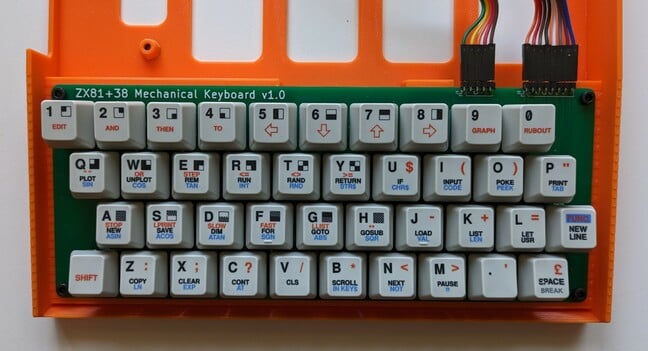The ZX81 finally gets the keyboard it deserves
Chap posts free specs for posh build with Cherry MX switches
Few computers polarize like the Sinclair ZX81. The cut-price micro is at once revered for being so cheap it introduced a generation to computing, and derided for the utterly unpleasant keyboard that made that introduction difficult for many.
The latter issue has been addressed – not a moment too soon. A chap named Brian Swetland has created a mechanical keyboard for the machine, and kindly published the specs and plans for it on GitHub.
On Twitter, Swetland told The Register he was one of the many turned on to tech by Sinclair – in his case by the MicroAce ZX80. He later crossed over to the Commodore 64, but later decided to revisit the ZX80 and ZX81.
As documented on his Mastodon feed, he's built a ZX81 clone – the ZX81plus38 to be precise – and while working on that project decided it needed a proper keyboard.
- Tales from four decades in the Sinclair aftermarket: Parts, upgrades and party tricks
- ZX Spectrum: Q&A with some of the folks who worked on legendary PC
- DIY Sinclair clones: Left it too late to back the Next? Build your own instead
- Thanks, Sir Clive Sinclair, from Reg readers whose careers you created and lives you shaped
In days of yore, several third-party manufacturers devised and sold keyboards for the ZX81. Most are lost to history. Swetland started from scratch, developing PCBs and finding an outfit to print custom keycaps that reproduced Sinclair's infamous arrangement allowing multiple commands to be typed from a single key after appropriate contortions.
He based the design on the Cherry MX switch – the kind of high-end keyboard kit that gets gamers drooling and can make statisticians weep with its massive mean time between failures.
On Wednesday he posted the fruits of his labors to GitHub, under a license that allows free use, modification, distribution and even sub-licensing.
Here's his work in all its glory.

Brian Swetland's mechanical keyboard for the ZX81. See https://github.com/swetland/zx81-keyboard/ for details – Click to enlarge
Swetland's repo includes KiCAD files for the schematic and layout, plus exported gerbers "generated for an order of five PCBs from JLCPCB."
He's also provided SVG files of the custom keycaps he acquired from WASD.
One thing he hasn't finished yet is an I/O interface for the keyboard – an omission he attributes to lack of "time to poke at that recently."
Perhaps by the time you've built your keyboard, he'll have finished that job. Or maybe retro-loving Reg readers will weigh in and help? ®
 Biting the hand that feeds IT
Biting the hand that feeds IT